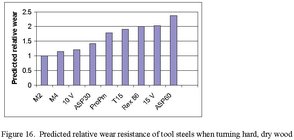Two ways to learn something: Ask an open-ended question or take the closed-ended approach, I'm doing that here, which is stating understandings to folks who may know better. I'm a hollow-former and my perspectives are from that discipline.
Bowl-guys make greater demands on both the design of the gouge and their ability to use the tool. Attributes like flute-shape and grind are primarily bowl-guy issues - doing an inside finish cut in one pass requires lots of variables to come together - hats off.
Hollow-form-guys (at least this one) use the gouge for outside profiling and rarely get more than 1/2" off the rest - tool presentation and direction are what works with least risk. However, like the bowl-guys, we need durable sharpness. Most of my efforts today are with mistletoe-burl mesquite - hardest and heaviest in N. America. And then I load that down with epoxy - thin epoxy to impregnate bark inclusions and thick in worm-holes and inclusions too small to be openings. I've settled on the Dway M42 with their standard grind.
I read the posts on this or that bowl gouge with interest but have not seen anything that makes me want to experiment. I've used Thompson and the V10 Glaser (red-handled) - never got the Thompson to perform and the only difference with the Glaser is price - why pay 2x for same results. ANY SUGGESTIONS?
Bowl-guys make greater demands on both the design of the gouge and their ability to use the tool. Attributes like flute-shape and grind are primarily bowl-guy issues - doing an inside finish cut in one pass requires lots of variables to come together - hats off.
Hollow-form-guys (at least this one) use the gouge for outside profiling and rarely get more than 1/2" off the rest - tool presentation and direction are what works with least risk. However, like the bowl-guys, we need durable sharpness. Most of my efforts today are with mistletoe-burl mesquite - hardest and heaviest in N. America. And then I load that down with epoxy - thin epoxy to impregnate bark inclusions and thick in worm-holes and inclusions too small to be openings. I've settled on the Dway M42 with their standard grind.
I read the posts on this or that bowl gouge with interest but have not seen anything that makes me want to experiment. I've used Thompson and the V10 Glaser (red-handled) - never got the Thompson to perform and the only difference with the Glaser is price - why pay 2x for same results. ANY SUGGESTIONS?

